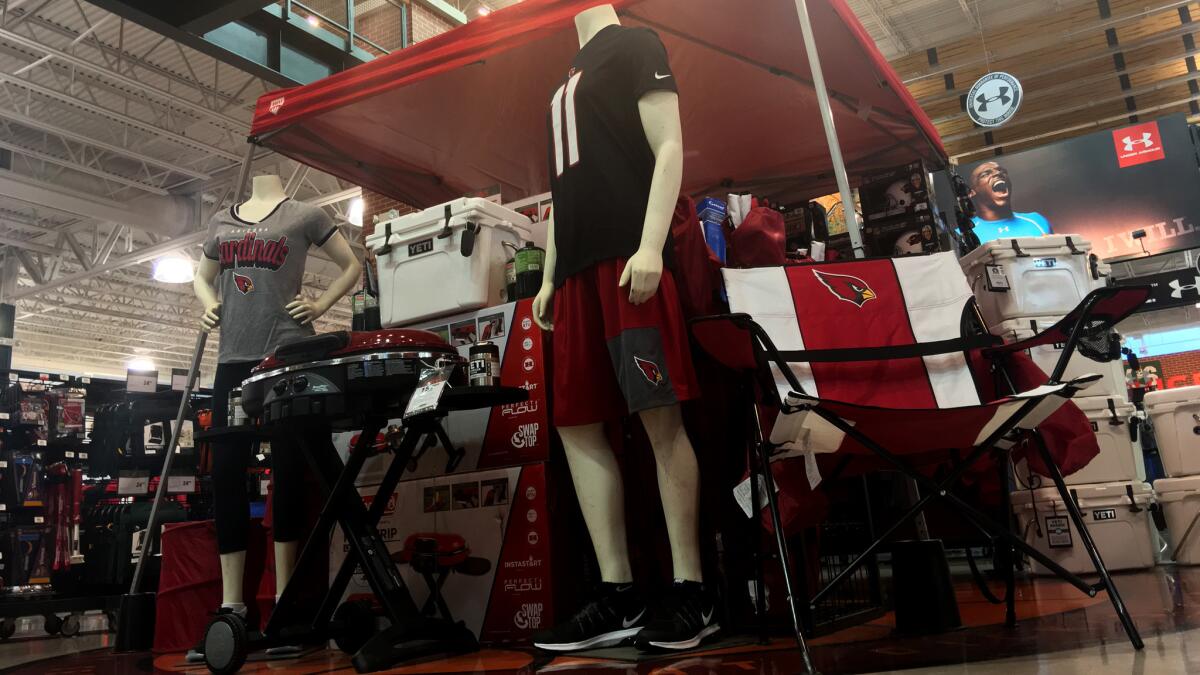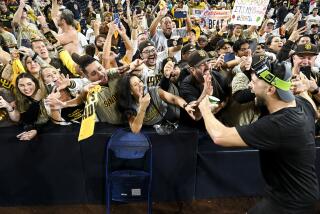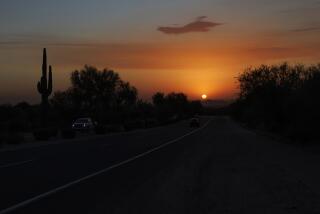Column: Arizona Cardinals, competitive and embraced by fans, have shown how to win over a city

Reporting from Phoenix â Los Angeles went two decades without an NFL team.
Sometimes, even though the Cardinals were here, Arizona felt that way too.
âThere were a lot of fans from the visiting team in the stands,â recalled retired quarterback Jake Plummer, who spent his first six seasons with the Cardinals. âIâd throw the ball and get hit, then listen for the crowd because I couldnât see the receiver. When the crowd would cheer Iâd think, âDid I complete that pass, or do I have to get up and play defense now?ââ
For years after the Cardinals moved from St. Louis to Arizona in 1988, ads were stapled to telephone poles touting tickets to games featuring popular out-of-town teams.
âIt was disheartening,â said Vai Sikahema, a former Pro Bowl returner who played five seasons for the franchise. âWeâd play the Cowboys and there would be more blue-and-white jerseys in the stands than there were red. Weâd play Chicago and it was packed with Bears fans. And later, when I played for the Eagles and Iâd go and play there â Philadelphians travel with their team â there would be a sea of green.â
Those were gloomy days for the NFL in the Valley of the Sun, when the Cardinals called Sun Devil Stadium home. Theyâre also days gone by. With a state-of-the-art stadium, a perennially competitive team, and an energized fan base, this city is painted a deep red.
The Cardinals, once dependably at the bottom of the NFL by any measure, are a case study in the value of rebranding. In many ways, they provide a blueprint for winning over a city, even without a Super Bowl victory.
Itâs not that the Cardinals have put their best foot forward this season, however. Theyâre 1-2 after losing their opener to New England at home, rebounding with a blowout victory of Tampa Bay, then taking another step backward with an upset loss at Buffalo.
The pressure is on for the Cardinals, who host the Rams on Sunday and then, for the first time in their history, have three consecutive prime-time games: at San Francisco on a Thursday, at home against the New York Jets on a Monday, and at home against Seattle in their second Sunday night game of the season.
When the Cardinals played in their old stadium, they were essentially the Washington Generals to the NFLâs Harlem Globetrotters. Their big selling point was they were the reason the Green Bay Packers, Pittsburgh Steelers, Dallas Cowboys and others came to town.
Consider that since University of Phoenix Stadium opened in 2006, each of the 109 home games has been a sellout. There were 12 sellouts in the teamâs 18 years at Sun Devil Stadium, and seven of those happened when the Cowboys came to town.
âWe had an NFL team, but we had an NFL team that the town hated,â former Cardinals center Ed Cunningham recalled. âOur marketing campaign was, âWeâre terrible and we have the highest ticket prices in the NFL.â Oh, and the city spent millions building them a practice facility that everyone was mad about.â
Thatâs a distant memory now, as this region has embraced the Cardinals with a fervor that matches that of some of the NFLâs most enthusiastic fan bases. For instance, vanity license plates are popular in Arizona, and particularly ones sold to sports fans.
According to the Arizona Department of Transportation, there were 8,823 specialty plates on the road in 2015 featuring an Arizona Diamondbacks background, and 4,231 in Phoenix Suns colors. As for Arizona Cardinals plates? 59,738.
There were a series of milestones in the turnaround of the Cardinals, none bigger than when the club finally moved into its own stadium in 2006. (They are pro footballâs oldest franchise, yet always shared a stadium with at least one other team.) Spearheading that effort was Michael Bidwill, whose father and grandfather had run the team before him.
Bidwill returned to the team in 1996 after a six-year stint as a federal prosecutor. Not only did he lead the effort for a new stadium, but he also promoted longtime scout Steve Keim to general manager and hired Coach Bruce Arians within a nine-day stretch in January 2013.
Arians and Keim â raised within 20 miles of each other in central Pennsylvania â inherited a 5-11 team and helped the Cardinals to 10, 11 and 13 victories in the past three seasons.
The way Cardinals quarterback Carson Palmer sees it, the stadium was the game-changer in terms of turning around the franchise. He was a rookie with Cincinnati in 2003, when the Bengals lost to the Cardinals, 17-14, before 23,531 at Sun Devil Stadium.
âIt was 190 degrees, there were 70 people in the stands, it was a 1 oâclock game, and it was awful,â Palmer recalled with a smile.
âNow, I feel like weâve got the best stadium in the league, until I go to see Minnesota or maybe the stadium theyâre building in L.A. Itâs world class, and I think that makes you feel the importance of this. Itâs like, âOK, weâre legit. We have Super Bowls in our stadium. We have a retractable roof.â This is the big time, and Iâve been places where they donât have those things. So you get that feeling of âWhatever it takes to win, weâll provide.ââ
Cardinals merchandise, once as rare as a snowman in the desert, now lines the walls of stores all over town.
âIâll never forget back in 1999, one of my first years as a scout here, I went to a Wal-Mart and I saw a guy with a Cardinals hat on,â Keim said. âI thought, âNo way! Thereâs a fan!â It was so few and far between to see somebody with Cardinals stuff on. Then I got up closer and saw there was a little tag hanging off the hat. It was from a supermarket giveaway.â
The Cardinals can laugh about those times now, those days when they were as rootless as tumbleweeds.
âYouâve got to be impressed with what theyâve done,â Cunningham said. âWhen they made it to the Super Bowl [at the end of the 2008 season], I got emotional. Itâs an NFL city now. Thatâs what you can say about Phoenix. Through better management and smart marketing, a new stadium that was done smart and well, and a connection to their audience, theyâve become a true NFL city.â
Twitter: @LATimesfarmer
More to Read
Go beyond the scoreboard
Get the latest on L.A.'s teams in the daily Sports Report newsletter.
You may occasionally receive promotional content from the Los Angeles Times.











